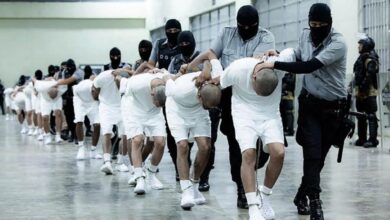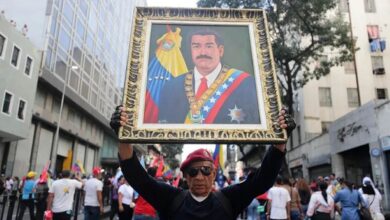How far does the power of the Public Force can go?
The death of protesters in Colombia and Chile by attacks by the Public Force has sparked a debate about the scope and protocols of these squadrons.

Police force present during a day of protests. / Photo: Pexels – Reference Image
LatinAmerican Post | Juliana Suárez
Listen to this article
Leer en español: ¿Hasta dónde llega el poder de la Fuerza Pública?
The Public Force has come to play an important role in social protests, for many it has been the role of villains. There are, however, those who defend that the police and the riot squad, or even the armed forces themselves, enter the demonstration scenarios to prevent them from getting out of control. On the contrary, most of those who take the streets reject their actions, ensuring that this is only the agent of the chaos that enters seeking to prevent social protest at all costs.
The truth is that, undoubtedly, the presence of these squads stresses the scenarios that, for the most part, try to be peaceful. As a result, recent demonstrations in Chile and Colombia have taken innocent lives. In Chile, more than 20 people have died in the demonstrations, while in Colombia, the 18-year-old Dilan Cruz became the flagship of the protests and the rejection of the Public Force.
Starting with Puerto Rico in July, in demonstrations that ended in the resignation of the then Governor, but followed by several countries in the region, people have taken to the streets to sue their governments on different aspects. Nicaragua, Venezuela, Ecuador, Bolivia and, those that are more latent at the moment, Chile and Colombia, are some countries that have decided not to remain silent for what they consider injustices of their governments.
Also read: How many victims have left the Latin American protests?
Despite attempts at pacification in these scenarios, it is often not enough and a peaceful day ends in detentions – sometimes arbitrary – and injured.
In this attempt to maintain public order, whether justifiably or arbitrarily, the Public Force uses dissuasive disturbance methods that end up obscuring peaceful protests and turning them into violent, mostly isolated acts. But what is blurred in these altercations is how far the use of the Public Force can go and how to determine when that scope is violated.
Basic principles
In principle, all use of the Public Force, both in conflict situations and in demonstrations, is governed by the 1949 Conventions and Gynec and its Additional Protocols. According to the report Violence and use of force of the International Committee of the Red Cross, "the authorities must observe the principles of legality, necessity, proportionality, and precaution." This would mean that in a demonstration, they could only take action when there is a previous violent attack.
The Colombian jurist, Daniella Baquero, focused on issues of Human Rights, International Humanitarian Law and International Criminal Law, spoke with LatinAmerican Post in order to understand the role played by the Police and others responsible for maintaining order in citizenship. Regarding this, Baquero affirms that the actions of riot squads, such as ESMAD in the case of Colombia, "are often disproportionate and they should only take action when there is already previous aggression."
All agents of the Public Force, in addition, have knowledge in Human Rights and in said protocols, which change depending on the squad that is or if it is an armed or unarmed conflict (as a demonstration). Men must have a “properly trained, professional and disciplined force to calm or disperse a crowd without resorting to force,” the same report mentions.
Despite the strict protocols, which also include a series of non-lethal weapons that are authorized to use only in certain ways, many times they are not met and these same facts are considered as abuse of authority. "For example, among those protocols is that the shots they take cannot go directly to any person but projected in free fall," says Baquero, although the opposite has been seen on occasion.
One of the criticisms that have been made during the recent demonstrations in the region is that the public force has begun to act at times when there was no chaos or disturbances, that is, it is not a quality of defense but of attack. But also, both in Chile and in Colombia, videos have shown that some parameters such as distance or the way it is shot are not met. “Many have done it from a higher level than the people who are sent tear gas and not a perpendicular launch, as they should,” says the Colombian lawyer.
Blind in Chile and military presence
The social outbreak of both Chile and Colombia has had a strong component against the Public Force for the alleged abuses that have been reported countless times.
In Chile, after the protests that began in October 2019, 20 have been fatalities due to street riots. But another fact that has been alarming in terms of scope abuse is that a large number of people have been blinded by tear gas.
Although the danger of these is known, the protocols are supposed to regulate that the scopes are not dangerous. However, at least 200 people have been affected in one or both eyes during the protests. The complaint against these actions is that the police have acted indiscriminately and, moreover, have pointed directly at the face of the protesters, as well as it has been said that the distances necessary to launch them have not been respected.
The Universal of Mexico emphasizes that, according to complaints from the Medical College of Chile and Human Rights organizations, the number of these injuries “is above the number of cases in France during the crisis of the 'yellow vests', the protests in Hong Kong and the Israeli-Palestinian conflict. "
Also read: Why do Chileans continue to protest?
The president of Chile, Sebastián Piñera, accepted at the time that in some situations, the Public Force had exceeded its power and there had been excessive actions. However, days later he announced that he would present a bill that would allow the deployment of army troops to the streets during social protests without the need to declare a state of emergency.
This action was flatly rejected by the protesters, precisely arguing the abuses experienced by the agents. Daniella Baquero, faced with the deployment of the Armed Forces in contexts of social protests in the streets of the city, said: “I think it is a literal declaration of war on protest and that the use of military force is a disarticulation strategy that seeks intimidation and persecution of people who are peaceful.” This, in addition to the Armed Forces protocols, are intended for other types of actions and have other scopes.
20 years and more than 30 dead in Colombia
For its part, Colombia witnessed an act of violence that has been rejected by a large part of its population against an 18-year-old Dilan Cruz by an ESMAD agent. Although the protest in this country has not had the same number of dead, injured or detained as in Chile, the death of this young student triggered the repudiation of an organization that in 20 years of existence carries the death of 34 people, most youth, students and / or indigenous.
Dilan Cruz's death occurred due to a direct launch of an ESMAD member in his head less than 20 meters away. According to the opinion, the weapon with which it was struck is one of those allowed in the action protocols. This weapon, in theory, is not lethal, but by breaking the protocols such as distance and aiming directly at the civilian, they were the ones who caused Cruz's death and call this organization into question.
The NGO Temblores published, following what happened, a report called Official Silence: a stunned cry of justice for 20 years of Esmad. This is related as since its inception, in 1999, the Mobile Riot Squad has taken innocent lives, the first being that of a street dweller just one year after its creation. The report "documents the deaths of nine students, nine peasants, nine indigenous people, two children, a worker, a street vendor and one more person whose activity was not specified," Semana collects.
Also read: Colombia: the National Strike continues and the pans will not stop ringing
The problem also lies in the submission to a strict chain of command. On the one hand, some agents have claimed that they shoot for following orders from some superior, although in other cases arbitrary actions of agents have been seen separately. “The principles and morals are subordinated to a chain of command,” says Baquero, “if the agent is told, shoot, he has to do it. Beyond the Human Rights that are taught, they are also taught that an order is everything. ”
This factor has been discussed and rejected in other aspects in Colombia, where private soldiers have had to carry out orders from their superiors, even if they go outside the legal framework of their actions. For the same, another of the deaths in the framework of the protests in this country was that of a 21-year-old soldier, Brandon Cely, who decided to take his own life by not being able to leave the army but also not allowing him freedom of expression.
Because of this, organizations such as Amnesty International and Human Rights Watch have had to raise their voices to denounce non-proportional attacks on civilians. In several reports, they have expressed the seriousness of the reprisals in the protests, such as the cases of people who lose their sight in Chile and have asked governments to investigate the abuses.





